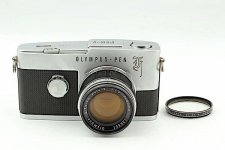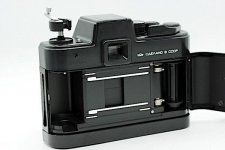Jason Schneider
the Camera Collector
Half Frame SLRs: The Olympus Pen F Series was a good start, but…
there were many more, including some you probably never heard of!
By Jason Schneider
The introduction of 35mm motion picture film around 1890 set the stage for the total transformation of analog still photography that took place over the 20[SUP]th[/SUP]century. The invention is credited to William Kennedy Dickson, a brilliant engineer working for Thomas Alva Edison, and 35mm-wide film, with four perforations on both edges of each 18 x 24mm frame, became the international standard for cinematography in 1909. Not surprisingly, many pre-Leica 35mm still cameras, notably the posh but ponderous Tourist Multiple of 1914 made by Herbert & Huesgen of New York, employed the standard 18 x 24mm cine format. The Simplex, an ingenious 35mm still camera made in Long Island City, NY around the same time, was the first to offer a choice of 18 x 24mm and 24 x 36mm formats, well before the full frame Leica I (Model A) debuted in 1925. In short, “Half Frame” still cameras have been around for well over a century. And some were on the market well before Simplex, and later E. Leitz, Wetzlar decided to double the size of the format to “Full Frame” 24 x 36mm to achieve sharper, better-quality enlargements on the slow, grainy, black-and-white films of the day.
By and large, and despite its oddball 2:3 aspect ratio, by the mid 1920s the 24 x 36mm full frame format came to dominate 35mm still photography, a trend that has persisted (with notable exceptions) even into the current digital era. However, there were dozens of half frame 35mm still cameras (notably the cute and competent Ansco Memo and Universal Camera Corp.’s ingenious Universal’s Mercury I and II) manufactured from the ‘20s through the ‘40s. Then came the half frame craze of the ‘60s through the early ‘70s that was ignited by the introduction of the gorgeous, minimalist, scale focusing, pocket-sized original Olympus Pen in 1959 and its many successors. While numerous companies, including Canon, Ricoh, Yashica, Petri, Fuji, and VEB Pentacon entered the half frame fray, none of them released an SLR.
The Olympus Pen F dynasty
Finally, in 1963, Olympus decided to extend its proven half frame prowess into the burgeoning SLR realm by offering its very first 35mm SLR, the Olympus Pen F (adorned with an impressive gothic F on the front). Introduced 9 years before the all too conventional M42 mount,. full frame Olympus FTL and the trendsetting ultra-compact full frame Olympus OM-1, the Olympus Pen F of 1963-1966 was the world’s first half-frame (18x24mm format) 35mm SLR designed specifically for this format (the limited-edition half-frame Alpa 9d, a masked-down version of the standard full frame Alpa 9d, arrived one year later in 1964.)
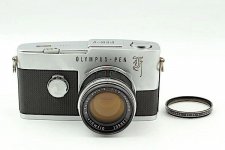
The Olympus Pen F with gothic F logo of 1963 was the first SLR based on the 18 x 24 mm half frame format. It sired the very successful Pen F series.
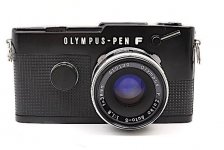
Olympus Pen FT looks beautiful in black with 38mm f/1.8 F. Zuiko lens, but its TTL metering system was inconvenient to use and it reduced finder brightness.
Designed by a team led by the legendary Yoshihisa Maitani (who also designed the original scale focusing Pen, the Pen F arrived at the height of the half-frame craze begun by its stablemates, the 19 (!) scale-focusing Olympus Pen models that began in 1959 and ended in 1981. Though meter-less, the Pen F created a sensation with such innovative features as an excellent line of bayonet-mount Zuiko interchangeable lenses (eventually ranging from 20mm to 800mm plus 2 zooms and a macro), a 2-stroke film-wind lever, a unique rotary-sector, metal focal-plane shutter (similar to the one in 24 x 24mm Robots from Germany) providing flash sync at all speeds from 1-1/500 sec, a horizontally-moving instant-return mirror, and a porroprism finder with bright full-focusing screen. An accessory coupled CdS meter prism bayoneted in place over the shutter-speed dial. With standard 38mm f/1.8 Zuiko lens the svelte Pen F measures a petite 5 x 2-3/4 x 2-1/2 inches. The later Pen FT (1966-1972) has a single-stroke wind lever, a built-in, inconvenient, transfer-the-setting TTL metering system (calibrated in an arbitrary sequence of numbers!), and a dimmer viewfinder due to the light siphoned off for metering. The final Olympus Pen Fv of 1967-1970, perhaps the nicest one of the lot, is basically a meter-less Pen FT with a brighter viewfinder. All are charming, very well-made user-collectibles. Prices for clean, functional examples with 38mm f/1.8 Zuiko Auto-S lens range from $125-$250 for a Pen F, $175-$320 for a Pen FT, amd $350-$450 for a Pen Fv. Rare black Pen Fs and FTs similarly equipped fetch $400 and up.
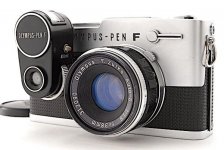
The Olympus Fv, shown with coupled accessory Pen F CdS meter. The last and best of the Pen F series it had a brighter finder plus other Pen FT upgrades.
The Leicaflex 18 x 24: A one-off working prototype
Even before the audacious Olympus Pen F went into production the wizards at E. Leitz Wetzlar were toying with the idea of coming out with a posh, elegant (and undoubtedly premium priced) half frame 35mm SLR. Sadly, the only known example of what would have been the Leicaflex 18 x 24 is a late working prototype of circa 1962. A thing of beauty designed by Helmut Müller, it features a rotary shutter mechanism, (similar to the ones in Olympus Pen F series cameras) providing shutter speeds of 1-1/1000 sec plus B, a unique left-handed “pull back” wind lever, a manually zeroed external frame counter like the one on the Leica M2, a smooth top without any pentaprism “hump,” and a specially designed bayonet mount 35mm f/2 Summicron lens. Evidently Leitz pulled the plug on the project in 1967, perhaps sensing that the half frame craze had peaked, and devoted their energies to developing the acclaimed M-series and modernizing their SLRs. Leitz did, of course offer the Leica 72, a rare half frame variant based in the Leica IIIf. Fewer than 200 of these cameras were made between 1950 and 1963, making it one of the rarest production screw mount Leicas, but it was a rangefinder camera not an SLR. The sole Leicaflex 18 x 24 is priceless. A Leica 72 will set you back at least $20K!
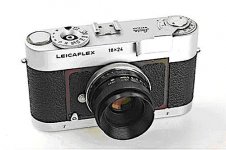
Leicaflex 18 x 24 prototype: It's gorgeous, has advanced features and a bayonet mount 35mm f/2 Summicron lens but Leitz pulled the plug and it's a one-off.
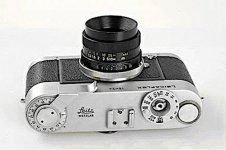
Top view of Leicaflex 18 x 24mm prototype shows manually zeroed frame counter, reverse action wind lever, shutter dial with speeds to 1/1000 sec.
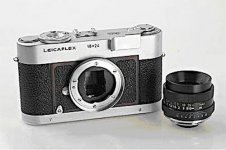
Front view of Leicaflex 18 x 24 with special 35mm f/2 Summicron lens removed shows bayonet mount and rotary focal plane shutter similar to Pen F"s.
The Nikon FM2 Half Frame
The Nikon FM2 is an advanced enthusiast- and pro-aimed 35mm SLR made by Nikon in Japan from 1982 to 2001. Re-released in 1984 with some incremental improvements (such as a higher flash-sync speed) the later version is commonly referred to as the FM2n although both versions are labelled as the FM2 on the front of the camera body. The FM2 incorporates an advanced Nikon-designed, metal-bladed, bearing-mounted, vertical-travel focal plane shutter with speeds of 1 to 1/4000 sec plus B, and a fast X-sync speed of 1/250 sec all without battery power. Measuring 90 x 142 x 60 mm (H x W x D) body only, and weighing in at of 540 g, the standard FM2 was available chrome or black, but the rare FM2 Half Frame made for the Norwegian Police was only available in chrome. One of the rarest production Nikons it’s estimated that only a few hundred Half Frame FM2s were made.
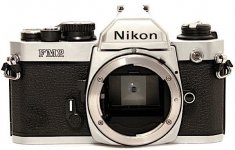
Rare Nikon FM2 Half Frame: With no external markings it sure looks just like a standard FM2--until you check out the inside or look through the viewfinder.
To identify a Nikon FM2 Half Frame you must look through the finder or open the back—externally it looks the same as a standard FM2. The edges of the Half Frame finder are blacked out revealing a central vertical viewing/focusing area on a standard focusing screen. Inside is a special one piece 18 x 24mm film gate, not a modified standard gate, Metering and other finder displays are identical to those in a standard FM2, and most are apparently based on the earlier version of the FM2 with a 1/200 sec top X sync speed. In effect the Nikon FM2 Half Frame knocked the Olympus Pen F/FT off its perch as the most extensive half frame SLR system because it accepts a vast array of Nikkor lenses and many Nikon accessories. What’s a Nikon FM2 Half Frame worth? You can snag standard FM2 in black or chrome with or without lens for about 300 bucks, and I’d peg the rare Half Frame version at close to 10 times that much—if you’re lucky enough to find one for sale.
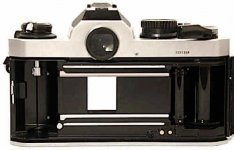
Open back view of Nikon FM2 Half Frame shows that the film gate has not been modified but is abbrand new unit specific to this model. Kudos to Nikon!
The Yashica/Kyocera Samurai
The Yashica Samurai (also sold in Kyocera badged versions) is a group of unique integrated half frame 35mm SLRs, all of which resemble compact video cameras and work like them too except that they use 35mm film and can’t shoot movies! All have an integral non-interchangeable phase-detect AF zoom lenses with wide/tele pushbuttons for zooming, motorized film wind and rewind, and built-in auto flash. The first model, the Samurai X3.0 unveiled in 1987, features a 14-element f/3.5-4.3, 25-75mm Yashica Zoom lens, an electronically controlled inter-lens shutter with speeds of 2-1/500 sec, programmed autoexposure (AE), an AF lock via the shutter release, sequence and 10 sec self-timer drive modes, optional on-film data imprinting, DX film speed coding from ISO 50-3200, and an eyepiece correction range of +1 to -4 diopters. It’s powered by one 6v 2CR5 lithium battery and has a reset (RS) button to restore the camera to operation if the microprocessor locks up.
The X3.0 was followed by the Yashica Samurai X4.0 of 1988 which features a 4X f/3.8-4, 25-100mm zoom lens and provides shutter speeds od 3-1/300 sec. The Kyocera Samurai Z and the Z2 of c.1990 were more compact, scaled down versions of the Samurai concept, the latter with a 12-element f/4.5-5.6 25-75mm Yashica Zoom lens, shutter speeds 2-1/500 sec, sequence shooting at up to 4.5 fps, data imprinting capability, self-timer, and pop-up flash. A left-handed model the Z2-L was also available and would sure make a fascinating collectible.
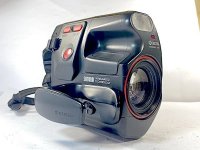
Kyocera X3.0 Samurai, also branded Yashica, was the company's first half frame zoom SLR with AE, AF, motorized film advance, and a cool video camera form factor.
Perhaps some camera crazed creative will get on the stick and come out with a retro anime adventure series called: Tales of the Left-Handed Samurai-
The Yashica/Kyocera Samurai X3.0 won the Japanese Camera Grand Prix award for its innovative design in 1988, and all half frame SLR versions sold reasonably well in Japan, butnever really caught on in the U.S. You can snag a clean functional Samurai X3.0 for around $75-$100 on the major online auction sites. The Samurai X4.0 if far less common and fetches about $150-$200. You’d better make sure it’s working perfectly and can be returned for a full refund if it’s not, because repairs are dodgy at best, and parts are unobtainable.
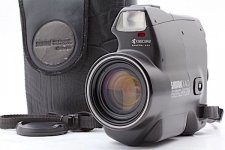
Kyocera Samurai X4.0 aka Yashica, was a follow-up to the X3. It had a longer 4X f/3.8-4 25-100mm zoom lens and other revisions but the basic form factor.
The Zenit MT-1 Surprise
Perhaps it’s not so surprising that the Russkys at the KMZ factory would come up with a half frame 35mm SLR designed for medical photography but labeling it “surpriz” in Cyrillic characters below the nameplate was somewhat unexpected. Unlike the Zenit 19 the camera is based on, the Surprise, which was made from 1979 to about 1990, has no light meter, and versions exist with top shutter speeds of 1/500 and 1/1000 sec respectively. They were also made with two different lens mounts, an M42 screw mount.
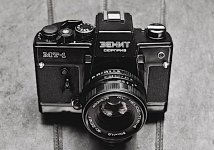
Zemit MT-1 Surprise: A clunky but competent half frame SLR designed for medical applications it was in production for nearly 20 years in various versions.
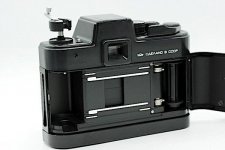
Open back view of Zenit MT-1 Surprise shows 18 x 24mm film gate aperture and metal bladed focal plane shutter. Logo says "Made in USSR."
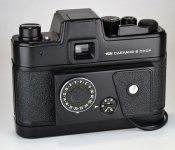
Back view of Zenit MT-1 Surprise shows neatly configured data back furnished with some examples. It has an on-film data imprinting function
There were 2 kit lenses available, a Helios 44M-4 50mm f/2 and a Helios 77M-5 50mm f/1.8, and another with a unique breech lock mount that accepted a matching 50mm f/1.7 Industar-50 MT and 30mm f/3.5 Mir-MT. Both these latter optics are fixed focus and have fixed apertures plus a spring-loaded latch for a lens cap. An endoscope adapter was also available for the breech-lock mount version, and some examples of the Zenit MT-1 Surprise have a fixed data back with an imprinting function. Film speeds from ISO (?) 16-500 determine the exposure time, and the data back is powered by three PX625 batteries. The good news: you can acquire of these exotic Soviet beauties for a mere $100-$200 depending on the lens, back, and overall condition.
there were many more, including some you probably never heard of!
By Jason Schneider
The introduction of 35mm motion picture film around 1890 set the stage for the total transformation of analog still photography that took place over the 20[SUP]th[/SUP]century. The invention is credited to William Kennedy Dickson, a brilliant engineer working for Thomas Alva Edison, and 35mm-wide film, with four perforations on both edges of each 18 x 24mm frame, became the international standard for cinematography in 1909. Not surprisingly, many pre-Leica 35mm still cameras, notably the posh but ponderous Tourist Multiple of 1914 made by Herbert & Huesgen of New York, employed the standard 18 x 24mm cine format. The Simplex, an ingenious 35mm still camera made in Long Island City, NY around the same time, was the first to offer a choice of 18 x 24mm and 24 x 36mm formats, well before the full frame Leica I (Model A) debuted in 1925. In short, “Half Frame” still cameras have been around for well over a century. And some were on the market well before Simplex, and later E. Leitz, Wetzlar decided to double the size of the format to “Full Frame” 24 x 36mm to achieve sharper, better-quality enlargements on the slow, grainy, black-and-white films of the day.
By and large, and despite its oddball 2:3 aspect ratio, by the mid 1920s the 24 x 36mm full frame format came to dominate 35mm still photography, a trend that has persisted (with notable exceptions) even into the current digital era. However, there were dozens of half frame 35mm still cameras (notably the cute and competent Ansco Memo and Universal Camera Corp.’s ingenious Universal’s Mercury I and II) manufactured from the ‘20s through the ‘40s. Then came the half frame craze of the ‘60s through the early ‘70s that was ignited by the introduction of the gorgeous, minimalist, scale focusing, pocket-sized original Olympus Pen in 1959 and its many successors. While numerous companies, including Canon, Ricoh, Yashica, Petri, Fuji, and VEB Pentacon entered the half frame fray, none of them released an SLR.
The Olympus Pen F dynasty
Finally, in 1963, Olympus decided to extend its proven half frame prowess into the burgeoning SLR realm by offering its very first 35mm SLR, the Olympus Pen F (adorned with an impressive gothic F on the front). Introduced 9 years before the all too conventional M42 mount,. full frame Olympus FTL and the trendsetting ultra-compact full frame Olympus OM-1, the Olympus Pen F of 1963-1966 was the world’s first half-frame (18x24mm format) 35mm SLR designed specifically for this format (the limited-edition half-frame Alpa 9d, a masked-down version of the standard full frame Alpa 9d, arrived one year later in 1964.)

The Olympus Pen F with gothic F logo of 1963 was the first SLR based on the 18 x 24 mm half frame format. It sired the very successful Pen F series.

Olympus Pen FT looks beautiful in black with 38mm f/1.8 F. Zuiko lens, but its TTL metering system was inconvenient to use and it reduced finder brightness.
Designed by a team led by the legendary Yoshihisa Maitani (who also designed the original scale focusing Pen, the Pen F arrived at the height of the half-frame craze begun by its stablemates, the 19 (!) scale-focusing Olympus Pen models that began in 1959 and ended in 1981. Though meter-less, the Pen F created a sensation with such innovative features as an excellent line of bayonet-mount Zuiko interchangeable lenses (eventually ranging from 20mm to 800mm plus 2 zooms and a macro), a 2-stroke film-wind lever, a unique rotary-sector, metal focal-plane shutter (similar to the one in 24 x 24mm Robots from Germany) providing flash sync at all speeds from 1-1/500 sec, a horizontally-moving instant-return mirror, and a porroprism finder with bright full-focusing screen. An accessory coupled CdS meter prism bayoneted in place over the shutter-speed dial. With standard 38mm f/1.8 Zuiko lens the svelte Pen F measures a petite 5 x 2-3/4 x 2-1/2 inches. The later Pen FT (1966-1972) has a single-stroke wind lever, a built-in, inconvenient, transfer-the-setting TTL metering system (calibrated in an arbitrary sequence of numbers!), and a dimmer viewfinder due to the light siphoned off for metering. The final Olympus Pen Fv of 1967-1970, perhaps the nicest one of the lot, is basically a meter-less Pen FT with a brighter viewfinder. All are charming, very well-made user-collectibles. Prices for clean, functional examples with 38mm f/1.8 Zuiko Auto-S lens range from $125-$250 for a Pen F, $175-$320 for a Pen FT, amd $350-$450 for a Pen Fv. Rare black Pen Fs and FTs similarly equipped fetch $400 and up.

The Olympus Fv, shown with coupled accessory Pen F CdS meter. The last and best of the Pen F series it had a brighter finder plus other Pen FT upgrades.
The Leicaflex 18 x 24: A one-off working prototype
Even before the audacious Olympus Pen F went into production the wizards at E. Leitz Wetzlar were toying with the idea of coming out with a posh, elegant (and undoubtedly premium priced) half frame 35mm SLR. Sadly, the only known example of what would have been the Leicaflex 18 x 24 is a late working prototype of circa 1962. A thing of beauty designed by Helmut Müller, it features a rotary shutter mechanism, (similar to the ones in Olympus Pen F series cameras) providing shutter speeds of 1-1/1000 sec plus B, a unique left-handed “pull back” wind lever, a manually zeroed external frame counter like the one on the Leica M2, a smooth top without any pentaprism “hump,” and a specially designed bayonet mount 35mm f/2 Summicron lens. Evidently Leitz pulled the plug on the project in 1967, perhaps sensing that the half frame craze had peaked, and devoted their energies to developing the acclaimed M-series and modernizing their SLRs. Leitz did, of course offer the Leica 72, a rare half frame variant based in the Leica IIIf. Fewer than 200 of these cameras were made between 1950 and 1963, making it one of the rarest production screw mount Leicas, but it was a rangefinder camera not an SLR. The sole Leicaflex 18 x 24 is priceless. A Leica 72 will set you back at least $20K!

Leicaflex 18 x 24 prototype: It's gorgeous, has advanced features and a bayonet mount 35mm f/2 Summicron lens but Leitz pulled the plug and it's a one-off.

Top view of Leicaflex 18 x 24mm prototype shows manually zeroed frame counter, reverse action wind lever, shutter dial with speeds to 1/1000 sec.

Front view of Leicaflex 18 x 24 with special 35mm f/2 Summicron lens removed shows bayonet mount and rotary focal plane shutter similar to Pen F"s.
The Nikon FM2 Half Frame
The Nikon FM2 is an advanced enthusiast- and pro-aimed 35mm SLR made by Nikon in Japan from 1982 to 2001. Re-released in 1984 with some incremental improvements (such as a higher flash-sync speed) the later version is commonly referred to as the FM2n although both versions are labelled as the FM2 on the front of the camera body. The FM2 incorporates an advanced Nikon-designed, metal-bladed, bearing-mounted, vertical-travel focal plane shutter with speeds of 1 to 1/4000 sec plus B, and a fast X-sync speed of 1/250 sec all without battery power. Measuring 90 x 142 x 60 mm (H x W x D) body only, and weighing in at of 540 g, the standard FM2 was available chrome or black, but the rare FM2 Half Frame made for the Norwegian Police was only available in chrome. One of the rarest production Nikons it’s estimated that only a few hundred Half Frame FM2s were made.

Rare Nikon FM2 Half Frame: With no external markings it sure looks just like a standard FM2--until you check out the inside or look through the viewfinder.
To identify a Nikon FM2 Half Frame you must look through the finder or open the back—externally it looks the same as a standard FM2. The edges of the Half Frame finder are blacked out revealing a central vertical viewing/focusing area on a standard focusing screen. Inside is a special one piece 18 x 24mm film gate, not a modified standard gate, Metering and other finder displays are identical to those in a standard FM2, and most are apparently based on the earlier version of the FM2 with a 1/200 sec top X sync speed. In effect the Nikon FM2 Half Frame knocked the Olympus Pen F/FT off its perch as the most extensive half frame SLR system because it accepts a vast array of Nikkor lenses and many Nikon accessories. What’s a Nikon FM2 Half Frame worth? You can snag standard FM2 in black or chrome with or without lens for about 300 bucks, and I’d peg the rare Half Frame version at close to 10 times that much—if you’re lucky enough to find one for sale.

Open back view of Nikon FM2 Half Frame shows that the film gate has not been modified but is abbrand new unit specific to this model. Kudos to Nikon!
The Yashica/Kyocera Samurai
The Yashica Samurai (also sold in Kyocera badged versions) is a group of unique integrated half frame 35mm SLRs, all of which resemble compact video cameras and work like them too except that they use 35mm film and can’t shoot movies! All have an integral non-interchangeable phase-detect AF zoom lenses with wide/tele pushbuttons for zooming, motorized film wind and rewind, and built-in auto flash. The first model, the Samurai X3.0 unveiled in 1987, features a 14-element f/3.5-4.3, 25-75mm Yashica Zoom lens, an electronically controlled inter-lens shutter with speeds of 2-1/500 sec, programmed autoexposure (AE), an AF lock via the shutter release, sequence and 10 sec self-timer drive modes, optional on-film data imprinting, DX film speed coding from ISO 50-3200, and an eyepiece correction range of +1 to -4 diopters. It’s powered by one 6v 2CR5 lithium battery and has a reset (RS) button to restore the camera to operation if the microprocessor locks up.
The X3.0 was followed by the Yashica Samurai X4.0 of 1988 which features a 4X f/3.8-4, 25-100mm zoom lens and provides shutter speeds od 3-1/300 sec. The Kyocera Samurai Z and the Z2 of c.1990 were more compact, scaled down versions of the Samurai concept, the latter with a 12-element f/4.5-5.6 25-75mm Yashica Zoom lens, shutter speeds 2-1/500 sec, sequence shooting at up to 4.5 fps, data imprinting capability, self-timer, and pop-up flash. A left-handed model the Z2-L was also available and would sure make a fascinating collectible.

Kyocera X3.0 Samurai, also branded Yashica, was the company's first half frame zoom SLR with AE, AF, motorized film advance, and a cool video camera form factor.
Perhaps some camera crazed creative will get on the stick and come out with a retro anime adventure series called: Tales of the Left-Handed Samurai-
The Yashica/Kyocera Samurai X3.0 won the Japanese Camera Grand Prix award for its innovative design in 1988, and all half frame SLR versions sold reasonably well in Japan, butnever really caught on in the U.S. You can snag a clean functional Samurai X3.0 for around $75-$100 on the major online auction sites. The Samurai X4.0 if far less common and fetches about $150-$200. You’d better make sure it’s working perfectly and can be returned for a full refund if it’s not, because repairs are dodgy at best, and parts are unobtainable.

Kyocera Samurai X4.0 aka Yashica, was a follow-up to the X3. It had a longer 4X f/3.8-4 25-100mm zoom lens and other revisions but the basic form factor.
The Zenit MT-1 Surprise
Perhaps it’s not so surprising that the Russkys at the KMZ factory would come up with a half frame 35mm SLR designed for medical photography but labeling it “surpriz” in Cyrillic characters below the nameplate was somewhat unexpected. Unlike the Zenit 19 the camera is based on, the Surprise, which was made from 1979 to about 1990, has no light meter, and versions exist with top shutter speeds of 1/500 and 1/1000 sec respectively. They were also made with two different lens mounts, an M42 screw mount.

Zemit MT-1 Surprise: A clunky but competent half frame SLR designed for medical applications it was in production for nearly 20 years in various versions.

Open back view of Zenit MT-1 Surprise shows 18 x 24mm film gate aperture and metal bladed focal plane shutter. Logo says "Made in USSR."

Back view of Zenit MT-1 Surprise shows neatly configured data back furnished with some examples. It has an on-film data imprinting function
There were 2 kit lenses available, a Helios 44M-4 50mm f/2 and a Helios 77M-5 50mm f/1.8, and another with a unique breech lock mount that accepted a matching 50mm f/1.7 Industar-50 MT and 30mm f/3.5 Mir-MT. Both these latter optics are fixed focus and have fixed apertures plus a spring-loaded latch for a lens cap. An endoscope adapter was also available for the breech-lock mount version, and some examples of the Zenit MT-1 Surprise have a fixed data back with an imprinting function. Film speeds from ISO (?) 16-500 determine the exposure time, and the data back is powered by three PX625 batteries. The good news: you can acquire of these exotic Soviet beauties for a mere $100-$200 depending on the lens, back, and overall condition.


